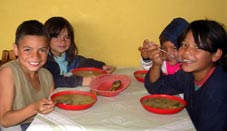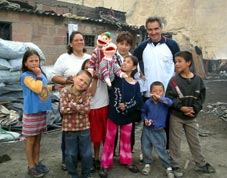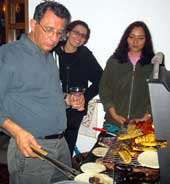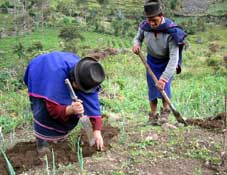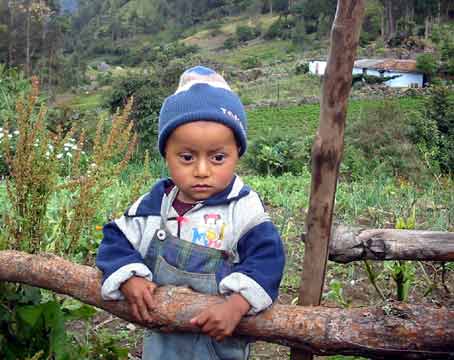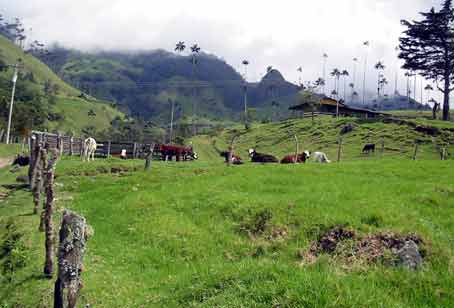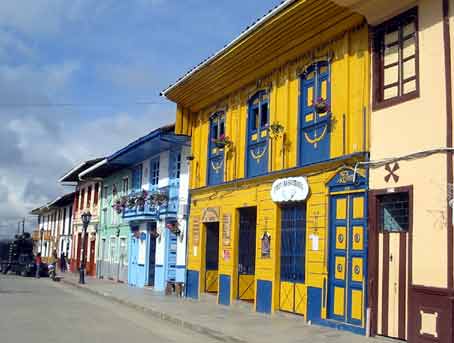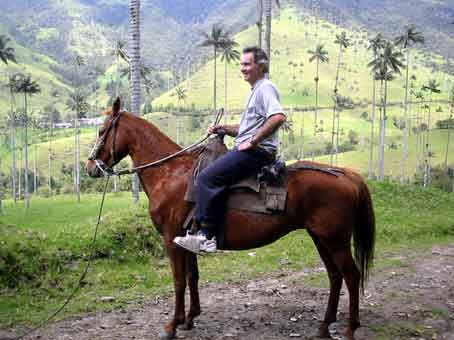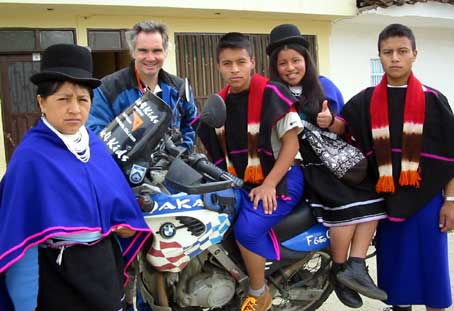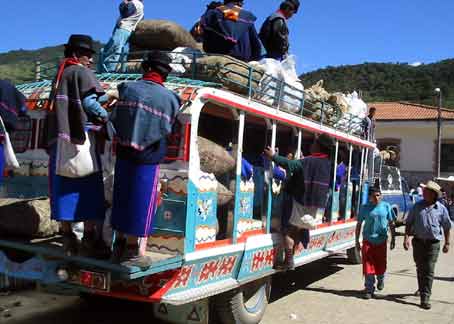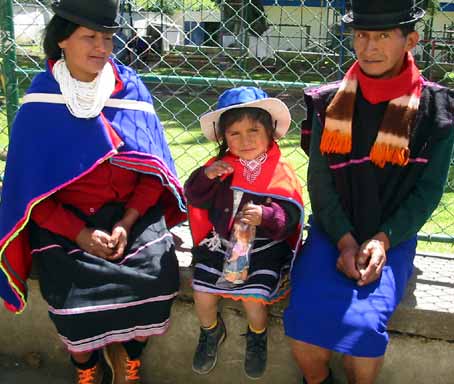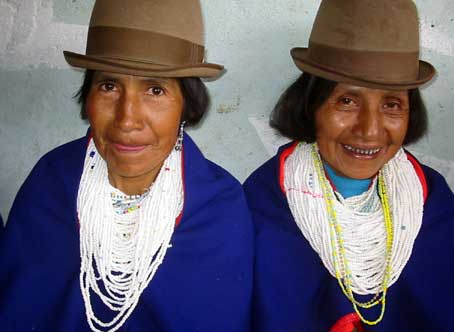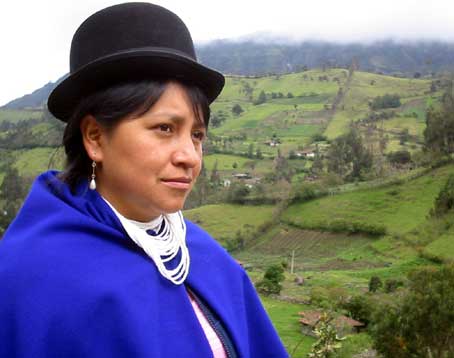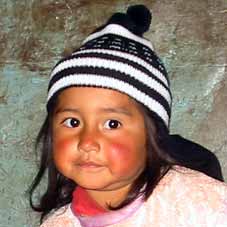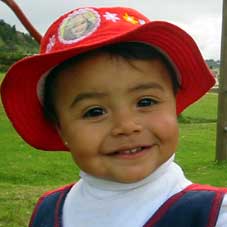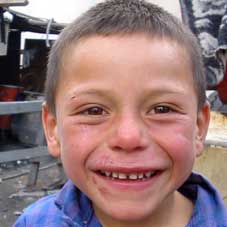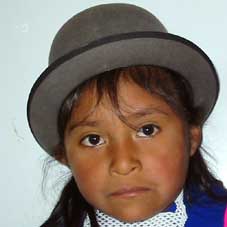Cocaine,
kidnappings and
beautiful women.
Wednesday,
3 December 2003.
The flight from Panama to Bogotá was only one hour, just enough time
to take off, have a little snack and land. We had no problem with the immigration
and we walk straight to Girag, the cargo company. You can understand how happy
I was when I saw the bikes. Mario, the manager, sent us to the custom in order
to clear the bikes. There, everyone was helpful and very friendly, and in no
time we were back to Girag and riding away. The bad news was that Simon
would not be able to join us for a while. Getting a visa with an Irish passport
is not the easiest thing to do due to a couple of IRA members getting caught
training some guerrillas a while ago. We rode to the centre of Bogotá
and by then it was getting dark. We managed to find the Platypus hostel
which seems to be a favourite place for the backpackers. The friendly owner,
Germán, arranged a safe place to park our bikes.
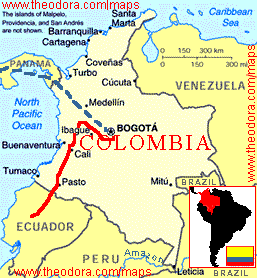
Colombia
was name after Columbus who did not even get as far as Colombia. When you mention
Colombia to most people they automatically think of kidnappings, cocaine barons,
guerrillas and murders. This is my fourth time in this country and it has always
been a favourite of mine. It is a country of amazing natural and cultural diversity
and contrast, where climate, topography, wild life, crafts, music and architecture
make it a wonderful place to visit. Also, it has not been spoil by tourism which
adds to its attraction. Its people form a palette of ethnic blends uncommon
elsewhere in South America and include a few dozen Indian groups, some of
which
still maintain traditional lifestyles like the Guambianos which I am hoping
to visit once more on this trip. Through its stormy and turbulent history, Colombia
has been soaked with blood in innumerable civil wars and has endured guerrilla
insurgency. The country is also the world's major producer of cocaine. With
such a background, it's no wonder that violence may occur here more frequently
than in neighbouring countries.
I got the following information from my good friend Krzysztof Dydynski,
author of the Colombian Lonely Planet. Colombia is roughly equivalent to the
combined area of France, Spain and Portugal and is the 4th largest country in
South America, after Brazil, Argentina and Peru. Colombia's physical geography
is amazingly diverse. The western part, almost half of the total territory,
is mountainous, with three Andean chains featuring some peaks above 5000m. More
than half of the territory east of the Andes is vast lowlands.
The Amazon occupies all of Colombia's southeast and lies in the Amazon
basin. Most of the land is covered by a thick rainforest crisscrossed by rivers.
It has a population of around 44 millions people. What I think attracts me most
to Colombia, apart from its stunning landscape, is its habitants. They are very
special people and it is very rare to meet such joyful, open-hearted, warm,
skilled and inspiring individuals.
Its capital, Bogotá, is a very big city with around 7 million
habitants. It has beautiful colonial churches, innovative architecture and intellectuals
which give it a vibrant and cultural life. But there are other things which
make it a little ugly as well. For example, I could mention its vast shantytowns,
streets urchins, beggars, thieves, itinerant vendors, wild traffic and graffiti.
It's a bustling, noisy and aggressive conurbation - amazing but awful, fascinating
but dangerous.
I would not have stayed in Bogotá but World Vision Colombia were
expecting me so I rode my bike to their office the following day. I was welcomed
by the attractive Sandra Borda and the not so attractive Samuel Albarracin
but nevertheless the operations director. After showing me around and introducing
me to many people, they organized for me to visit a project the following day.
World Vision has been operating in Colombia since 1976. Currently, 51,000 children
are sponsored which means that 300,000 people receive training and support.
Having said that, there is still a lot to be done as 6,5 million children in
Colombia live in conditions of poverty, 6 million are part of the rows of armed
groups, 4,5 million suffer from some type of abuse and 850,000 are abused in
severe ways. The official balances indicate that 64% of the Colombians live
in poverty conditions. These families survive with US$85 per month. To give
you an idea of the cost of living in Colombia, a litre of petrol cost 50US cents,
a very basic meal in a cheap restaurant cost around US$3, an haircut for a man
is US$3 and a dozen of eggs cost around one dollar. A family of 6 or 8 cannot
survive with such little money because they have to pay for the housing, food,
education, clothing and health. In general terms, these families do not manage
to cover the nutrition basic needs of children and adults. Around 14 million
people do not even reach this poverty level. In the zones where World Vision
Colombia develops its projects, the panorama is furthermore worrying. Some family
receive only 0,36 cents of a dollar per day and the lowest income were detected
in the city of Cali when a family receives 0,11 cents per day to live.
You can find out more about what WV Colombia does by visiting their web site:
www.visionmundialcolombia.org.co
One thing that I find very encouraging in Colombia though is the fact that Colombians
themselves sponsored children in their own country. This is the first time that
I witness such a thing. 12,000 children are currently sponsored by Colombians
which is incredible
when you know that only 15% of the population could afford it.
Friday, 5 December.
That morning, I arrived early at the national office and after singing some
Christmas chorals with the entire office staff we left to visit a project in
a shantytown near Bogotá. The football fan Daniel Enrique Páez
was my translator for the day. To combat the malnutrition problems, WV has
created some restaurants for the children.
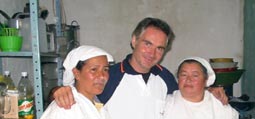
The
one we went to visit was run by Carmen. This very dedicated lady feeds
around 150 children every day. She has only a couple of other ladies to help
her and together they provide an healthy meal once a day and 6 days per weeks
to those children. Before having this job, Carmen had no occupation but
now
she feels very useful and happy with her life. Among the children that came
to eat their lunch that day there were 6 who need to be mention. Their mother
had run away two months earlier with a man and had not returned since. Furthermore,
all the children had a different father and none of them were around. The oldest
child, a girl of 12 years of
age,
was left to care for her other 5 brothers and sisters. I did not see their house
but I was told that they did not even have water. Actually, the whole shantytown
doesn't have water and they rely on a truck that comes every day to bring it
to them. I was told that the truck had not been around in the last 8 days.
My
next visit was even worse. It was a family (pictured) of 11 children and no
husband. The mother was working three days and three nights per week in the
next door charcoal factory for a total of 10 US dollars. But this is not the
worst part. They live not only next to the charcoal factory but also next to
a plant where they burn bones to make fertilizers. The smoke and the bad smells
were unbelievable. The shack where they live had no water and only a couple
of beds. A couple of years
earlier,
one of the girls got raped. She was only 5 years old and the attack was so brutal
that she had to spend one month in an hospital. The man, who worked at the charcoal
factory, was arrested and is now in prison.
Two months ago, one of the other girls was raped, this time the 16 years old.
The police has done nothing about it yet and the man still hangs around and
threaten the girl. He, apparently, hangs around with another woman who supplies
the children for him to rape. This area is extremely dangerous; nevertheless,
the children have to walk every day to school.
I was told that World Vision Australia is just about to start a new project
in this area; actually it will start in January. If you would like to help,
you can check the Australia web site
or send them an email. I can assure you that some of those children are really
desperate for your help and with Christmas around the corner, what better gift
could you give. Remember, it's only a dollar per day but a dollar goes a long
long way in Colombia.
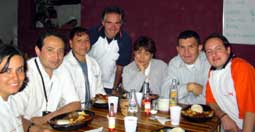
I
would like to thanks the whole WV team who took me around that day (pictured).
Keep up the good work guys, you are doing a remarkable job.
That night, I was invited for a Colombian BBQ at Samuel Albarracin's house.
We were joined by some of his colleagues from the World Vision
national
office. I would like to thanks Samuel and his wife Sandra for a most exotic
evening. I took the following day off. At 2,600m, Bogotá is a cold city
and the rain was not making it pleasant either so one day off was just enough
for me and I left the next day for Armenia.
Steffen, the bearded monkey, was not keen on spending any time in Colombia but
I had more projects to visit so I decided to keep going on my own while Steffen
raced toward Ecuador. I left Bogotá on a cold but dry sunny morning.
I was a little nervous been on my own, I had heard so many tragic stories
that I was imagining the worse scenarios. After a couple of hours of riding
I had recovered my confidence and I was feeling very good to be in Colombia.
As the road went down the temperature raised. Then I started to climb again
reaching the highest point at 3800m. It was very foggy and cold at the top but
no rain. The road was in very good condition with not much traffic to slow me
down. Soon, it got warmer and the weather cleared as I approached Armenia.
I was stopped by the army just before it but
once they had checked out all my documents they became friendly and I was able
to have a chat with them. There are three organisations that control the country,
the guerrillas, the Paramilitary and the army. I had full trust on the latest.
Even though I think that Colombia is a wonderful country there are some facts
that cannot be ignored. For example, there were 27,840 murders in 2001
or three murders per hour, 3000 reported kidnappings that same year. However,
this is not the
complete
picture as many kidnappings (an estimated 5000) go unreported and are dealt
with privately. In that year about 3700 civilians lost their lives as a result
of the armed conflict between various internal forces, including guerrillas,
paramilitaries, drug lords and the army. About 190,000 peasants were internally
displaced that year. The worst thing that happened to me in Colombia so far
was been mugged by 4 guys armed with knives who left me in the middle of nowhere
in my under pants (somewhere on the Caribbean coast). They had taken everything
else including shoes, tee-shirt and socks. During the attack, they kept on saying
that they were not going to kill me but as they were holding me down on the
ground, they started to have a go at my knickers and this is when I really started
to panic as I thought that they were going to rape me (please kill me first!)
but all they were doing were checking if I had any money in there. They left
me on a rugged mountain slope and it took me hours to get back on a road as
I could hardly walk due to the ground roughness and the extreme heat. By the
time I got back to civilisation, I was a mess; sunburned and dehydrated. That
was in 1994.
I was going to Armenia to visit a World Vision project but I did not really
want to stay there so I went to Salento instead. Salento is a lovely
village which gives the impression that the 20th century got lost somewhere
down the road. It has an attractive plaza and many fine old colonial houses,
and its proximity to Los Nevados gives it a noticeable mountain atmosphere
and appearance. I found a family who was renting rooms for around US$6 which
was perfect for me. I t is always a plus when you can stay with local people.
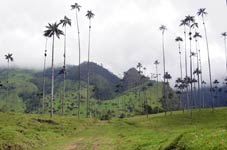
The
next day I rode to the valley of Cocora on a 12km rough dirt road. The
most spectacular part of the valley is the hills covered with the "Palma
de cera", a very special kind of palm. With its life span of 200 years,
it's the world's tallest palm variety, growing up to 60m. At the same time,
it has an unusually slim trunk, which makes it look striking, almost unreal.
I meet an Irish girl who was working as a volunteer for a year in
Colombia and, together, we walked around the
hills for a couple of hours. It was an astonishing sight. Apparently, this
is the only place in the world with such a landscape. By the way, this palm
tree is the Colombia's national tree.
Tuesday, 9 December.
That day, I rode to Armenia (35km) to visit a WV project. Armenia is
a medium size city set in the 'zona Cafetera', Colombia's coffee-growing heartland.
Zona Cafetera is a rugged and verdant land, with coffee plantations
covering most mountain slopes between about 1300m and 1700m. This region is
geologically unstable and was struck by serious earthquakes a number of times.
Armenia was wrecked by a catastrophic earthquake during January 1999.
My translator and good friend by now, Daniel Enrique Páez, was
waiting for me at the office.
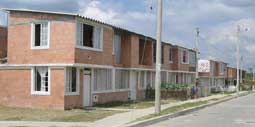
My
main interest in Armenia was to see the houses that had been given to sponsored
families following the 1999 tragic earthquake. So they took me there. World
Vision gave 112 housed to the same number of families affected by the earthquake.
The houses cost was US$5,193 which was assumed by WV as part of a donation that
tries to mitigate
the
natural disaster consequences. There are another 12 houses that need to be built
but they have run out of funds. On our way there, we stopped to visit a couple
of families who are waiting
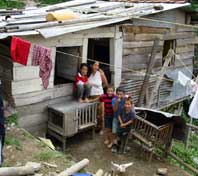
for
such houses. The first one (photo) was a family of 7 children. The husband had
built that shack himself. The house consisted of two rooms, with only two single
beds for 9 people. That whole family lives in the most appalling conditions.
The second one (below) was a family of only three, the father and his two children.
The mother had walked away and did not want anything to do with the children.
The boy was two and half and the little girl 5 years old. WV had given the father
a stove and some cutleries but this area is very dangerous and all that stuff
had been stolen from him. He was cooking their food outside on a fire. Again,
their conditions of living were dreadful. World Vision is hoping to receive
more funds in order to finish those houses as soon as possible.
I returned to Salento in the evening for a couple of resting days.
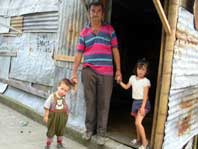
Friday,
12 December.
My next stop was in Silvia, a small village some 360 km south of Salento.
As usual, I left early to avoid the afternoon rain. I went through Cali, the
third largest city in Colombia, in mid-morning. Even though Cali is noted
for the beauty of its women and the hot rhythms of salsa music, I decided to
bypass it to gain time. I arrived in Silvia early in the afternoon, dry and
in good spirits. Silvia is one of my favourite places in the country.
Silvia is a very picturesque small village in the centre of the Guambiano
Indian region. The Indians don't actually leave in Silvia but in many small
mountain hamlets scattered throughout the area. There are about 12,000 of them
in the region. The guambianos are considered one of the
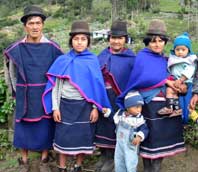
most traditional Indians groups in Colombia.
They have preserved their culture remarkably well given their proximity to,
and contact with, the modern world. They speak their own language, dress traditionally
and still use rudimentary techniques in agriculture. The men wear skirts.
World Vision has a small project here but before I get into that report
let me tell you about the "has anyone seen Didier? He has disappeared"
story.
I was supposed to meet with Daniel Enrique Páez, my football
friend
from WV, who had came all the way from Bogotá and was going to be once
again my translator. WV had booked us a room which we were going to share. The
visit of the project was schedule for the following day. I did not really know
at what time Daniel was arriving so I waited for him around the plaza, having
told the staff at the hotel about my intentions. At around 6pm, I decided to
go for a stroll through the town to kill time. As I was walking along, I meet
some people that I knew from my last visit, 10 years ago. They told me that
they were going to a graduation's party near by and that I was most welcome
to come along. I thought that it should not take more than one or two hours
at the most and that I would be back on time to meet up with Daniel. As it turned
up, the graduate was a young guambiano Indian and I could not believe that I
was given the chance to experience such an occasion. You have to understand
that those Indians are quite timid and reserved. It is not very easy to meet
them, let alone party with them. I was introduced to the family and the 4 of
us were sited in one room. All the other guests were Guambianos and were in
a different room. First, they brought us a small plate of rice salad, then a
small piece of cake (and I mean a small piece) with a tiny plastic cup of Champagne.
The Latin music was hot and loud. I had no idea what was going on, I mean the
4 of us in one room and the other in another and not mixing. They brought us
another round of Champagne (2 tablespoons worth in each cup). Then we were asked
to move to the other room as the graduate was about to make a speech. He was
standing behind a table with his mum and dad. In front of him were a few bottles
of aguardiente (a very popular local brandy flavoured with anise). His mum was
next to him and she had a few bottles of Champagne in front of her. His dad
was next with some kind of red wine in a big soup bowl. A large plate, with
dry biscuits and lollies, was also waiting patiently on the table. The graduate
said a few words timidly and we were invited to queue up and to take a cup of
each alcohol, a biscuit and a lolly. I got my cup of aguardiente from the graduate,
a cup of Champagne from Mrs Robinson and the red wine from Mr Robinson without
forgetting the sweets. The 4 of us sat back in our room thrilled at the idea
of eating our dry biscuit. I was just about to start to talk to my empty plate
(the fly on the wall was not answering my questions) when the ambience changed
radically. The music went up and suddenly there were 4 couples dancing in our
room. Next, I was dancing meringue with a tiny but energetic Guambiano's lady
with her little hat balancing dangerously on her head. The men, in their dressers,
seemed to have two left feet and were trying their best to impress their partners.
In no time the party was full on, everyone was dancing and the air was full
of the scent of aguardiente. But before you get the wrong idea, let me describe
the dance floor for you. All the men and women were wearing exactly the same
traditional outfit; most of them were middle age and looking weathered. As the
night went on, the drunken men seemed to be hanging desperately to their partners.
Indians, not unlike the Aborigines in Australia, don't have much resistance
to alcohol and get intoxicated very quickly. They say that 'time flies when
you are having fun' and it did. Soon, like Cinderella, I was keeping a nervous
eye on the time, midnight was approaching fast. Every time I mention that it
was time to go they would insist that I stayed a little longer. By 2am we finally
left and I walked back to the hotel to find everyone waiting for me. Daniel,
the hotel manager and the head of the local WV were worried sick about my whereabouts.
They had searched all the local bars, asked hundred of people in vain and finally
contacted the police. They were persuaded that I had been kidnapped by the guerrillas
which is very present around this region. If it had been the case it would have
been a catastrophe for WV. They gave me a serious talk and we finally got to
bed at 4am in the morning. I dreamed of been tortured by little men in dresses.
They were forcing me to applaud them as they were dancing the salsa in their
gumboots.
I do apologise to everyone involve and I am sorry to have caused all that unnecessary
anxiety.
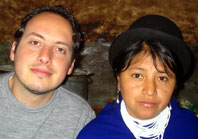
The
next morning, we met Maria Antonia Yalanda (pictured with Daniel) at
8am for our schedule visit. Maria, a Guambiano herself, is in charge of the
project and has been working for WV for the last 9 years. She told me that she
was very keen to learn English. This project focuses mainly to help the Guambiano
community. It is funded by Taiwan and has around 900 sponsored children.
The gaol of WV is to help this community with education, health and agriculture
without changing their
culture
which to my eye is a very fine line.
The main income for those families is agriculture. To help them, WV has created
a cooperative which give them better revenue when selling their products and
also an easy way to sell it.
We started our tour by visiting a family who was living deep in the mountain.
At 3000m high, the air was thin and very cool. I was getting out of breath every
time we were walking. Thankfully we drove there on a dirt road and it took us
around 45 minutes to get there. The scenery was amazing; I could see little
houses on the slope of the mountain amid verdant landscapes. A river, with extremely
clear water, was serpentine the bottom of the valley.
In the pass, women were mainly raising children and working the land, having
no education whatsoever. WV vision is changing that. They are working hard to
encourage parents to send their children, and not only the boys, regularly to
school. The family, that we visited, has three sponsored children and the oldest
girl, Diana, had just graduated and is going to university next year to study
history. She is a very self assured young lady and will be definitely a leader
in her community in the future. That evening was her graduation and they were
expecting 300 guests.
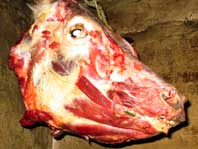
They
had killed a cow which the head was freshly hanging in the kitchen (pictured)
and was supposed to stay there for quite awhile. They offered us a plate of
rice with meat from the dead cow. Daniel and I had just taken our breakfast
not long before so we were definitely not hungry and the head of that cow just
centimetres away from us did not help anything. It is very impolite to refuse
food so we tried our best to swallow as much as we could but the meat was so
tough that I just could not eat it (the
vengeance
of the cow, you can actually see her smiling). I was relieved to see that Daniel
was facing
the
same dilemma. All the neighbouring ladies had come to help out to prepare the
food for the party and they were all sitting around peeling potatoes (pictured)
while the men were discussing the latest weather conditions.
Our next stop was another sponsored family. There, I was able to find out more
about their way of living. They showed me inside their house, which was very
Spartan. One lady was making hand-woven garments. The Guambianos are very good
weavers. The kitchen was very dark; the walls were
black
from the smoke of the fire which was burning on the floor in the middle of the
room. A frame was on top of the fire with a pot of water on it. Outside, there
were chickens and dogs running around.
There
was also a cage with guineas pigs which they eat. The father and the mother
were working in the field (pictured) not far from the house. They mainly grow
potatoes, corn and other local vegetables which I don't know the name in English.
On our way back, we stopped to see a group of men building a house. They have
a very strong sense of community and they help each others when big tasks are
to be done. Around 10 men were working and I was told that the house would be
completed in less that two weeks.
Once again, I want to say thank you to World Vision Colombia,
they
have been exceptionally helpful. Special thanks to my good friends Daniel Páez
and to the remarkable Maria Antonia Yalanda and I apologize for giving them
so many headaches.
Special
appeal. While in Silvia, I met a 2 years old boy who could not walk.
His name is Juan David Fernandez (pictured with his grandma)and he is
not a sponsored child. He has no feeling whatsoever in his two legs from the
knees down. He was born like that and his parents, who are very poor, cannot
afford an operation or the equipments necessary to help him walk. At the moment
I have no idea of how much it would cost but if anyone is interested to help
him I would be more than happy to pass on the information. So please,
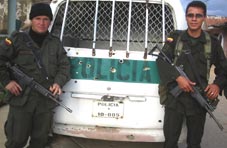
As
I have told you already, Silvia is not very safe and to illustrate it I took
a photo of the local police van. The vehicle is covered with bullet holes all
over. Last year, the police station was blown away, killing 2 policemen and
injuring many more in the process.
On a lighter note, I would like to talk to you about something that has bothered
me for awhile. Throughout Central America and probably South America, you cannot
throw toilet paper in the toilet because the pips are too small and it blocks
them. There is a
basket next to the loo to disregard the used
paper (always a good look and a nice smell). Those countries have cable TV,
mobile phones and internet so how come nobody has come out with the idea of
using bigger pips in the toilets? This is a problem that puzzles me.
Saturday, 20 December 2003
Well, I have just spent an excellent week in silvia and many people insist
that I stay here with them for Christmas. I am very tempted as it would be
quite an experience to spend Christmas with the Guambianos but a person that
I know quite well but for obvious reasons I cannot name, knows someone from
the local guerrillas. She told me that they are getting closer to Silvia and
that they have been asking a lot of questions about me. What was I doing here?
Who do I work for? When am I planning to leave? Etc… That person advised
me to leave as soon as possible. I think that I have stretched my luck far
enough so tomorrow I will disappear at first light toward Ecuador. I am still
some 800km from the border and there are a couple of places that I would like
to visit before saying goodbye to Colombia.
Last year I spent Christmas in Kenya, this year; will it be Colombia or Ecuador?
Ride4kids wishes you a Merry Christmas and all the best for the New Year.
Click here for more photos.
send
me an email if you are interested. What a Christmas gift that would be!
JOURNAL 30.
20/12/03 . Colombie . Kilométrage
total 56,115km .
La Cordillère
des Andes, l'Amazone
et la mer Caraïbe.
Mercredi
3 Décembre 2003.
Le vol de Panama à Bogotá n'était que d'une heure, juste
le temps de décoller, de casser une petite croûte et d'atterrir.
Nous passions l'immigration sans aucun problème et allions directement
à la compagnie de cargo. Comme il était déjà trois
heures de l'après-midi, je ne me faisais guère d'illusion sur
nos chances de récupérer nos motos ce jour là. Nous ne
savions même pas si elles étaient arrivées. Je rencontrais
le directeur de la compagnie et de sa fenêtre il me montrait nos motos.
Une joie indescriptible s'emparait de moi et si je n'ai pas embrassé
le directeur c'est grâce à mon compagnon Steffen (voir le journal
sur les Etats-Unis pour comprendre ma jubilation). Nous allions à la
douane, qui heureusement ne se trouvait qu'à quelques centaines de mètres,
remplir les papiers nécessaires pour l'entrée de nos motos en
Colombie. Les douaniers, qui étaient tous très aimables et obligeant,
nous faisaient ça en un temps record et à 18 heures nous roulions
vers la capitale. La seule mauvaise nouvelle c'était que Simon n'allait
pas pouvoir nous rejoindre avant un certain temps. Obtenir un visa pour les
Irlandais n'est pas chose facile pour des raisons politiques. Une autre chose
pas facile c'était de trouver un hôtel dans nos prix dans une ville
que nous ne connaissions pas. Pour compliquer les choses il faisait nuit et
la circulation était effrayante. Nous trouvions finalement un hôtel
convenable avec un propriétaire sympa qui nous trouvait une place de
toute sécurité pour garer nos motos.

Pour
ceux qui ne seraient pas au courant, la Colombie a été
baptisé d'après Christophe Colombe, bien que celui-ci ne
l'a jamais atteint. Il suffit de parler de la Colombie pour que les gens pensent
automatiquement aux kidnappings, drogue, guérillas et meurtres. C'est
la quatrième fois que je viens en Colombie et c'est un de mes pays favoris.
C'est un pays plein de variétés et de contrastes naturelles et
culturelles ou le climat, la géographie, la musique et l'architecture
en font un pays merveilleux à découvrir. Il a aussi l'avantage
de n'être pas un pays touristique ce qui augmente son attraction. Sa population
est aussi très variée, on y trouve encore plusieurs groupes d'indigènes
comme par exemple les Guambianos que j'espère pouvoir voir pendant
mon séjour. Pendant son instable et sa turbulente histoire, la Colombie
a été trempé dans le sang dans de nombreuses guerres civiles
et a du
supporté beaucoup de révoltes.
Ce pays est aussi l'un des principaux producteurs de cocaïne. Avec une
histoire pareille, il n'est pas étonnant que la violence y soit plus
fréquente que dans les pays voisins.
La Colombie est aussi grande que la France, l'Espagne et le Portugal réunis
et c'est aussi le 4ième plus grand pays d'Amérique du Sud, après
le brésil, l'Argentine et le Pérou. Sa géographie est
aussi très variée, la cordillère des Andes, l'Amazonie
et la côte Caraïbe.
Elle est peuplée d'environ 44 millions d'habitants. Ce qui m'attire
le plus en Colombie, à par la beauté de ces paysages, c'est
ses habitants. Ceux sont des gens très chaleureux et c'est très
rare de rencontrer des gens si joyeux, radieux, affectueux et excitants.
Sa capitale, Bogotá, est une très grande ville d'environ
7 millions d'habitants. Elle a de très belles églises coloniales,
une architecture avant-garde et des intellectuelles, ce qui lui donne un air
culturel. Mais il y a aussi beaucoup d'autres choses qui la rendent plutôt
de mauvais goût. Par exemple, je pourrai mentionner ses bidonvilles,
ses mendiants, ses voleurs, ses vendeurs ambulants, sa circulation sauvage
et ses graffitis. C'est une active, bruyante et agressive agglomération
- merveilleuse mais affreuse, fascinante mais dangereuse.
Il fallait quand même que j'y passe quelques jours car j'étais
attendu au bureau national de World Vision Colombie. J'y allais donc
le jour suivant avec ma moto et j'étais reçu par l'adorable
Sandra Borda et aussi par Samuel Albarracin, le directeur des
opérations. Après m'avoir présenter à de nombreuses
personnes, il m'invitait à visiter un projet, qui se situait dans les
bidonvilles, pour le lendemain.
World Vision est en Colombie depuis 1976. En ce moment, 51 milles enfants
sont parrainés, ce qui veut dire que 300 milles personnes bénéficient
de l'aide de WV. Néanmoins, il y a encore beaucoup à faire car
6,5 millions d'enfants en Colombie vivent dans la pauvreté, 6 millions
font parti des groupes armés, 4,5 millions sont abusés d'une
manière ou d'une autre. En bref, 64% de la population Colombienne vivent
dans des conditions de pauvreté. Ces familles survivent avec 80 Euros
par mois. Pour vous donner une idée du coût de la vie en Colombie,
un litre d'essence coûte50 centimes, un litre de lait 60centimes, un
repas très simple dans un restaurant 3 Euros, une visite chez le coiffeur
pour un homme 3 Euros, une douzaine d'œufs 1 Euros. Une famille de 6
ou 8 ne peut pas survivre avec si peu d'argent par ce qu'ils doivent aussi
payer le louer, l'éducation des enfants, les habits et les soins de
santé. En termes générales, ces familles n'ont pas les
moyens de couvrir les frais de l'alimentation nécessaire des enfants
et des adultes. Environ 14 millions de personnes n'atteignent même pas
ce niveau de pauvreté. Dans les quartiers où WV développent
ces projets, le panorama est encore plus inquiétant. Certaines familles
ne reçoivent que 36 centimes par jour. Vous pouvez en savoir plus en
consultant le site Web de WV en Colombie. www.visionmundialcolombia.org.co
Une chose que je trouve très encourageante en Colombie c'est le faite
que les Colombiens, eux-mêmes, parrainent des enfants de leur propre
pays. C'est la première fois que je vois ça et je trouve ça
formidable. 12 milles enfants sont parrainés par les Colombiens ce
qui est extraordinaire quand on sait que seulement 15% de la population en
ont théoriquement les moyens.
Vendredi 5 Décembre 2003.
Ce matin là, j'arrivais de bonne heure au Bureau de WV et après
avoir chanter quelques chansons de Noël avec tout le personnel ils m'emmenait
visiter un projet dans une favelas prés de Bogotá. Pour combattre
les problèmes de malnutrition, WV a crée des restaurants pour
les enfants. Celui que nous

visitions était dirigé par Carmen,
une personne très courageuse et très enthousiasme et qui avait
seulement deux autres femmes pour l'aider. Ensemble, ils nourrissent 150 enfants
chaque jour, sauf le dimanche. Le repas est servi seulement une fois par jour
mais il est très équilibré. Parmi les enfants qui sont
venus ce jour là il y en a 6 qui méritent d'être mentionner.
Cette famille de 6 enfants, dont l'aînée n'a que 12 ans, ont
tous un
père
différent (aucun ne sont dans la région) et dernièrement
leur mère les a abandonné et a disparu avec un autre homme. Ils
n'ont aucune nouvelle depuis trois mois. C'est l'aînée des filles
qui s'occupe de ses 5 frères et sœurs. Je n'ai pas vu leur maison
mais on m'a dit qu'il n'y avait même pas d'eau. D'ailleurs, dans ces bidonvilles,
c'est un camion citerne qui fourni l'eau mais ce dernier n'est pas venu depuis
plus de 8 jours. Ces gens là vivent dans les pires conditions imaginables.
Ma
visite suivante était encore pire. C'était une famille de 11 enfants
(photo ci-dessous) sans père. La mère travaillait 3 jours et 3
nuits par semaine dans une usine de charbon juste à côté
de chez eux, pour
exactement
10 Euros par semaine. Non seulement vivent-ils à côté de
cette usine qui fume nuit et jour mais aussi à côté d'une
fabrique d'engrais. L'engrais est faite à partir d'os d'animaux qui sont
brûlés. La fumée et les odeurs étaient insupportables.
Le baraquement, où ils vivent, n'a pas d'eau et seulement 4 lits pour
toute la famille. Deux ans plus tôt, une des filles fut violée.
Elle n'avait que 5 ans à l'époque et l'attaque fut si violente
qu'elle due passer un mois à l'hôpital. L'homme, qui travaillait
à l'usine de charbon, fut arrêté et il est toujours en prison.
Il y a deux mois, une autre des filles fut violée, celle-ci n'a que 16
ans. La police n'a toujours rien fait et l'homme est
toujours
en liberté. Dernièrement, il a menacé la jeune fille de
la violer encore une fois si elle portait plainte. Le pire, c'est qu'il a une
femme avec lui qui l'aide a trouvé des enfants pour qu'il puisse les
violer ensuite. Cet endroit est extrêmement dangereux, néanmoins,
les enfants doivent marcher chaque jour pour aller à l'école.
WV travaille très dur dans cette région mais il manque non seulement
de moyen financier mais aussi de sécurité. Ce projet est pris
en main par les Etats-Unis
Le lendemain je prenais une journée de repos bien mérité.
A 2600m d'altitude, Bogotá est une ville où il fait frais et la
pluie ne la rendait pas plus sympathique non plus. Une journée de repos
dans ces conditions me suffisait et je reprenais la route le lendemain pour
Armenia.
Mon collègue Steffen n'était pas très enthousiaste
à l'idée de rester en Colombie et il voulait en sortir le plus
rapidement possible mais comme j'avais encore plusieurs projets à visiter,
je continuais la route tout seul. On se retrouvera au Pérou ou en Bolivie.
J'ai quitté Bogotá par un matin froid mais ensoleillé.
J'étais un peu inquiet de voyager seul en Colombie, j'avais entendu tellement
d'histoires tragiques que je m'imaginais des scénarios ahurissants. Après
2 heures de route, j'avais retrouvé la confiance et mon optimiste légendaire.
A fur et a mesure que la route descendait la température remontée.
Puis la route c'est remis à grimper, les vues étaient grandioses
et je passais un col à 3800m. La température avait redescendu
précipitamment et je me retrouvais dans un brouillard épais mais
sans pluie. J'étais dans la Cordillère des Andes, seul avec ma
moto, je réalisais un rêve de gamin. La qualité de la route
m'avait surpris car je m'attendais à une petite route de montagne qui
n'avait pas été réparé depuis de nombreuses années.
Ce n'était pas le cas, la route était superbe avec peu de circulation.
Quelques camions se traînaient dans la montée mais tous me faisaient
signe de passer. Après une descente non moins
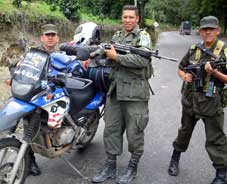
spectaculaire,
j'apercevais au fond de la vallée la ville d'armenia. L'armée
m'arrêtait juste avant d'y arriver et après vérifié
tout mes documents ils sont devenus très aimable ce qui me permettait
de discuter avec eux. Il y a trois organisations qui contrôlent le pays,
les guérillas, les paramilitaires et l'armée. Ces derniers sont
les moins dangereux et j'avais confiance en eux. Bien que je pense que la Colombie
est un pays merveilleux, il y a des faits que l'on ne peut pas ignorer. Pour
vous donner un exemple on va prendre l'année 2001 comme modèle.
Cette année là, il y a eu plus de 27,840 meurtres ou 3 meurtres
par heure, 5000 personnes ont été kidnappées, 3700
citoyens
ont trouvés la mort dans des conflits entre différentes forces
comme les guérillas, paramilitaires, les narcotrafiquants et l'armée.
Environ 190,000 fermiers ont dues tout laisser derrière et ceux sont
réfugiés dans d'autres endroits plus calmes de Colombie. La pire
des choses qu'il m'est arrivé en Colombie jusqu'à maintenant c'est
de me faire braquer par 4 bandits armés de couteaux et qui m'ont laissé
dans un coin perdu, en slip (quelques part sur la côte Caraïbes).
Ils m'avaient tout pris, chaussures, tee-shirt, chaussettes, short et montre
(quand on se promène à pied dans ce pays, on laisse tout ces papiers
et argent à l'hôtel). Pendant l'attaque, ils n'arrêtaient
pas de me dire qu'ils n'allaient pas me tués (ce qui me réconforté
un peu) mais ce qui m'inquiéta beaucoup plus c'est quand ils ont commencé
à baisser mon slip. Quelle panique! Car je pensais qu'ils allaient me
violer (s'il vous plait, tués moi en premier!) mais non, ils regardaient
juste si je n'avais pas d'argent caché par là. Ils m'ont laissé
sur un flanc de montagne rocailleux et cela m'a pris des heures pour retrouver
la civilisation. Je pouvais à peine marcher car sans chaussures, mes
petits petons sensibles, n'étaient pas prêts pour une telle randonnée.
La soif et les coups de soleil se faisaient ressentir aussi car le soleil brillait
très fort avec une chaleur extrême. Quand j'ai pu finalement regagner
la civilisation j'étais dans un état pitoyable, assoiffé,
brûlé et griffé de partout. C'était en 1994.
J'allais à Armenia pour visiter un autre projet de WV mais l'idée
de rester à Armenia ne me tentait guère et j'allais à Salento
à la place. Salento est un charmant petit village qui donne l'air
que le 20ième siècle est resté derrière sans jamais
l'atteindre. Il a une séduisante place et beaucoup de vieilles maisons
coloniales. Sa proximité de Los Nevados (chaîne de montagne)
lui donne un atmosphère de région montagneuse. Je trouvais une
famille qui louait des chambres pour 5 Euros ce qui m'arrangeait car c'est toujours
plus sympa de découvrir comment vivent les gens de la région.

Le
lendemain j'allais faire un tour dans la vallée de Cocora en empruntant
un chemin de terre de 12 km. Ce qui rend cette vallée si spectaculaire
ceux sont ces collines couvertes de 'Palma de cera ' une sorte de palmier
très spécial. Ces palmiers vivent environ 200 ans et atteignent
60m de hauteur, un record mondial en ce qui concerne la hauteur des palmiers.
Apparemment, c'est la seule place au monde où l'on peut trouver un tel
panorama. Je rencontrais une Irlandaise qui travaillait comme volontaire pendant
un an en Colombie et ensemble,
on
se promenait quelques heures à pied dans la région et je dois
dire que je n'ai jamais observé un paysage si magnifique. Cet arbre est
l'arbre national de la Colombie.
Mardi 9 Décembre.
Ce jour là, je retournais à Armenia (35 Km) pour visiter un
projet de WV. Armenia est ville moyenne en plein milieu de la région
du café de Colombie. Zona Cafetera est une région très
verdoyante avec des plantations de café qui couvrent les flancs de
montagne entre 1300m et 1700m. C'est aussi une région géologiquement
pas sûr ou les tremblements de terre y sont fréquents. En Janvier
1999, Armenia fut détruit par un catastrophique tremblement de terre.
Le centre ville n'a toujours pas été reconstruit complètement
et l'on y voit encore les ruines d'anciens bâtiments.
Mon ami et traducteur Daniel Páez (WV Bogotá) était
venu spécialement pour m'accompagner pour cette

visite.
La raison principale de ma présence à Armenia était de
voir les maisons que WV avaient construits pour les familles parrainées
suite au tragique tremblement de terre de 1999. WV ont construit 112 maisons
(photo) pour les familles démunies mais ils en ont encore 12 à
construire, malheureusement ils n'ont plus assez d'argent pour les finir. J'en
profitais pour visiter deux familles qui attendaient leurs nouvelles maisons.

La
première (photo), était une famille de 7 enfants. Le mari avait
construit le baraquement lui-même à l'aide de tôles ondulées
et de bambous. Je n'ai aucune idée comment cette maison tient encore
debout. Elle consiste de deux pièces dont la chambre qui a seulement
deux petits lits où dorment 9 personnes. Incroyable! Cette famille vit
dans des conditions déplorables.
La deuxième famille (photo ci-dessous)consistait d'un père, sa
fille de 5 ans et son fils de 2ans. La mère les avait abandonné
et ne voulait rien à voir avec ses enfants. Encore une fois, la famille
vivait dans des conditions pitoyables, sans aucun confort et le papa ne pouvait
pas aller travailler car il devait s'occuper de ses enfants. WV leurs avaient
donné un petit fourneau, quelques assiettes et des couverts mais ce coin
est aussi très dangereux et récemment, tout leurs avait été
volés. Le père cuisinait dehors sur un feu de bois. WV espèrent
recevoir bientôt des fonds pour pouvoir finir les 12 maisons aussitôt
que possible. Noël est proche et je ne peu m'empêcher de penser
à toutes ces familles qui vivent le jour le jour sans aucune espérance.
Comment vont-ils passer ce jour? Comme tous les autres jours de leurs vies sans
aucun doute pendant que nous allons faire la fête et dépenser beaucoup
d'argent sans aucun souci pour le lendemain.

C'est dans la mélancolie que je retournais
à Salento pour quelques jours de repos.
Vendredi 12 décembre.
Mon escale suivante était Silvia, un autre petit village à
quelques 360 Km au sud de Salento. Comme d'habitude, je partais tôt
pour éviter les pluies d'après-midi. Je passais la ville de
Cali, la troisième plus grande ville de Colombie, sans m'y arrêter.
La ville de Cali est réputée pour ses jolies femmes et pour
sa musique chaude et rythmé. Tant pis, cela sera pour la prochaine
fois. J'arrivais à Silvia en début d'après-midi, pas
mouillé et satisfait d'y être enfin car ce charmant village est
l'un de mes favoris dans ce pays.
Silvia est une commune très pittoresque en plein cœur de la région
où vivent les indiens Guambianos. Les indiens

n'habitent
pas vraiment à Silvia mais dans des petits hameaux parsemés dans
la montagne avoisinante. Ils sont environ 13,000 dans la région. Les
Guambianos sont considérés comme les plus traditionnels
indiens de Colombie. Ils ont conservés leurs cultures remarquablement
quand on considère le contact et la proximité qu'ils ont avec
le monde moderne. Ils parlent leur propre langue, s'habillent de leurs costumes
traditionnels et cultivent encore leurs terres avec des techniques rudimentaires.
WV ont un projet avec eux mais avant de vous en parler j'aimerai vous raconter
une mésaventure qui s'intitule "Mais Où est donc Didier?
Il a
disparu!"
J'étais supposé rencontrer Daniel
Páez, mon ami de WV Bogotá, venu spécialement pour
m'aider, ce soir là. WV nous avez réservé une chambre d'hôtel
que nous devions partager. La visite du projet était prévu pour
le lendemain. Je ne savais pas vraiment à quelle heure Daniel devait
arriver et je l'attendais à l'arrêt de bus ayant indiqué
aux personnels de l'hôtel mes intentions. Vers 18 heures, je décidais
de faire un tour dans le village histoire de faire passer le temps. Pendant
la promenade, je rencontrais des gens que j'avais connus lors de ma dernière
visite en 1994. Ils me disaient qu'ils allaient à une petite fête
en l'honneur d'un adolescent qui avait reçu son certificat d'étude
et que j'étais le bienvenu. Je pensais que cela ne prendrait pas plus
d'une heure ou deux et que j'aurai largement le temps de retrouver Daniel. La
famille était des Guambianos et j'étais impressionné à
l'idée d'avoir l'occasion d'assister à une telle cérémonie
avec une telle compagnie. Il faut comprendre que les Guambianos sont des gens
très réservés et très timides. C'est très
difficile pour un étranger de les rencontrer et d'avoir la chance d'être
leur invité, était une chose inespérée. On me présentait
à la famille et on installait mes trois compagnons (qui n'étaient
pas des indiens) et moi-même dans une pièce démunie de meubles.
Tous les autres invités étaient des Guambianos et ils étaient
dans une pièce voisine. On nous servait une assiette de riz avec quelques
légumes dans une petite assiette en plastique puis une minuscule part
de gâteau (j'insiste sur le mot minuscule car je ne trouve pas d'autres
adjectives pour décrire la grandeur du gâteau) ainsi qu'un petit
godet en plastique (pas beaucoup plus grand qu'un dé à coudre)
de champagne. Je n'essaye pas de vous dire qu'ils étaient radins mais
seulement de vous décrire les choses telles qu'elles étaient.
Bien que la musique Latine donnait un air de fête à la cérémonie,
je ne comprenais pas pourquoi nous devions rester dans notre pièce et
eux, dans la leur. On nous resservait un dé un coudre de champagne et
on trinquait gaiement à la pensée que la bouteille n'était
pas prête d'être vide (la soirée allait être longue).
Finalement, on nous invitait à rejoindre le reste des invités
car le diplômé s'apprêtait à porter un toast. Ce dernier
se tenait derrière une table avec papa et maman. Devant lui, sur la table,
il y avait quelques bouteilles d'aguardiente (un alcool très fort
et très populaire avec un goût d'anis).
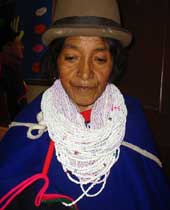
Sa
maman (photo)était prés de lui avec d'autres bouteilles de champagne.
Son papa, au bout de la table, avait devant lui un grand bol plein de vin rouge
mélangé à je ne sais quoi. Une large assiette, remplie
de biscuits et de bonbons, attendait patiemment sur la table entre les bouteilles.
Le diplômé disait quelques mots timidement et on nous invitait
à faire la queue pendant que tour à tour on devait boire un dé
à coudre de chaque alcool sans oublier le biscuit et le bonbon. Je retournais
dans notre pièce, avec mes compagnons, excité à l'idée
de manger mon biscuit. Je m'apprêtais à discuter avec mon assiette
vide (car la mouche sur le mur ne répondait pas à mes questions)
quand l'ambiance changea complètement. Le son de la musique monta de
plusieurs crans et soudainement, plusieurs couples indiens dansaient devant
nous. Peu après, je dansais le meringué avec une petite
mais
énergique Guambiano indienne alors que son petit chapeau melon se balançait
dangereusement sur sa tête.
Les hommes, portant des jupes, n'avaient pas du tout l'air doué et essayaient
de leurs mieux d'impressionner leurs partenaires. La fête avait commencé,
tout le monde dansait et l'air transpirait d'une odeur d'aguardiente. C'était
vraiment drôle de voir tous ces indiens habillés tous dans leur
habit traditionnel. Alors que la soirée progressait, les plus souls semblaient
s'accrocher désespérément à leur campagne. Les indiens,
un peu comme les aborigènes en Australie, n'ont pas beaucoup de résistance
à l'alcool et sont intoxiqués très rapidement. Le temps
passa et je m'amusais comme un fou, tout le monde voulait danser avec moi et
je faisais de mon mieux pour les satisfaire. Eventuellement, un peu comme Cendrillon,
je regardais nerveusement ma montre car minuit approchait. Je me faisais un
peu de souci parce que Daniel devait sûrement se demander où j'étais
passé. A chaque fois que je mentionnais qu'il était l'heure que
je parte, ils insistaient pour que je reste un peu plus longtemps. Finalement,
vers 2 heures du matin, j'étais libéré et je rentrais à
pied à l'hôtel pour trouver tout le monde qui m'attendait. Alors
que je passais la porte de l'hôtel la fleur aux dents j'étais accueilli
par 4 visages soucieux et fatigués. Daniel, le responsable de l'hôtel
et deux membres du personnel de WV étaient morts d'inquiétude
à mon sujet. Ils m'avaient cherché partout, interrogé des
centaines de personnes, en vain, Didier avait disparu. Ils avaient même
alerté la police, le dernier recourt. Ils étaient persuades que
j'avais été enlevé by la guérilla qui est très
présente dans cette région. Un cas pareil aurait été
une catastrophe pour WV. Ils me faisaient la morale et on se couchait vers 4
heures du matin. Je rêvais que j'étais torturé par des petits
bonhommes, dans leurs jupes et qui me forçaient à les applaudir
alors qu'ils dansaient la Salsa dans leurs bottes en caoutchouc.
Je m'excuse auprès de tout le monde à qui j'ai causé tant
d'inquiétude pas nécessaire.

Le
lendemain, nous retrouvions Maria Antonia Yalanda (photo avec Daniel)
à 8 heures pour notre visite. Maria, une Guambiano elle-même, est
responsable du projet et travaille pour WV depuis 9 ans. Le travail de WV est
d'essayé d'aider la communauté Guambianos. Etrangement, ce projet
est financé par la Taiwan et à environ 900 enfants parrainés.
Le but de WV est d'assisté cette communauté par l'éducation,
la santé et l'agriculture sans changer leurs cultures, leurs habitudes
et leur façon de vivre.
Le revenu principal de ces familles est l'agriculture. Pour les aidés,
WV a crée
une
coopérative qui les assiste dans la vente de leurs produits en augmentant
aussi le prix de vente.
Nous avons d'abord visité une famille qui habitait loin dans la montagne.
A 3000m d'altitude, l'oxygène se faisait rare et il ne faisait pas très
chaud. J'étais essoufflé chaque que fois que nous marchions, manque
d'habitude nul doute. Heureusement nous avions une voiture pour nous y emmener.
La route n'était qu'un chemin en terre que la pluie avait rendu impraticable.
La vue était fantastique; je pouvais voir des petites maisons, au flanc
de la montagne, entourées d'agriculture et de volailles. Une rivière,
avec une eau très claire, serpentait la vallée.
Auparavant, les femmes s'occupaient des enfants et travaillaient dans la ferme,
sans aucune éducation. WV sont en train de changer ça. Ils encouragent
les parents à envoyer les enfants à l'école et pas seulement
les garçons. La famille que nous visitions ont trois enfants qui sont
parrainés et l'aînée, Diana, vient juste de recevoir
son diplôme et va pouvoir entrer à l'université l'année
prochaine. Elle veut étudier l'histoire. C'est une jeune fille sûr
d'elle même et sera un jour une personne importante dans sa communauté.
Ce soir là, ils fêtaient ça et environ 300 invités

étaient
attendus. Ils avaient tué une vache dont la tête pendait fraîchement
dans la cuisine (photo) et devait, apparemment, y rester un certain temps. Ils
nous offraient une assiette de riz avec un peu de viande de la défunte.
Daniel et moi venions juste de déjeuner et nous n'avions certainement
pas faim, la tête de la vache, juste à quelques centimètres
de nous, n'arrangeait rien. C'est toujours impoli de refuser de la nourriture,
nous nous forcions quand même à avaler autant que possible mais
la viande était tellement dure que je ne pouvais pas la manger (la vengeance
de la vache, d'ailleurs, vous pouvez la voir sourire).
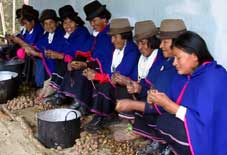
J'étais
réconforté de voir que Daniel avait les mêmes problèmes
que moi. Toutes les voisines étaient venues pour aider et elles étaient
toutes assises dehors et pelaient des patates pendant que les hommes discutaient
du changement de temps.
Une autre famille nous attendait un peu plus loin. Cette fois pas de fête
dans l'air ce qui me permettait de pouvoir découvrir comment ils vivent.
Ils me montrèrent l'intérieur qui était de toute simplicité,
aucun meuble, juste deux lits. Dans un coin, une femme tissait. Les Guambianos
sont très doués pour le tissage et ils font tous leurs vêtements
eux-mêmes. La
cuisine
était très sombre, les murs étaient noirs par la fumée
du feu qui brûlait à même le parterre et qui servait aussi,
bien sur, pour faire cuire les repas. Dehors, il y avait des chiens et des poules
qui circulaient librement. Il y avait aussi une cage avec des cochons d'indes
(cobayes). Ces derniers sont mangés comme on mange un lapin, au four
avec des pommes de terre (non, ce n'est pas la rubrique 'carte postale gourmande').
Le père et la mère travaillaient dans les champs,
non loin de la maison. Ils cultivent surtout des pommes de terre, maïs
et d'autres légumes dont je ne connais le nom en Français.
Encore une fois, je veux remercier WV Colombie, ils ont tous été
exceptionnellement accueillant et n'ont pas hésités une seule
fois à faire de leur mieux pour m'aider. Spécial remerciements
à mon ami Daniel Páez et à l'admirable Maria Antonia Yalanda.
Je m'excuse encore une fois de leur avoir causer tant d'anxiété.
Pendant
mon séjour à Silvia, j'ai rencontré un enfant de deux ans
qui ne pouvait pas marcher. Il s'appelle Juan
David
Fernandez (photo avec sa grand-mère) et il n'est pas parrainé.
Ses jambes sont paralysés du genou jusqu'au pied. Il est né comme
ça et ces parents, qui sont très pauvres, n'ont pas les moyens
de le soigner. En ce moment, je n'ai aucune idée du prix d'une opération
ou de l'équipement qu'il aurait besoin pour marcher mais si vous étiez
intéressés de lui venir en aide, je serai très content
de vous mettre en contact avec la famille et WV Colombie. Envoyez moi un email
si vous pensez que vous pouvez l'aider: didierm@comcen.com.au
...........Quelle beau cadeau de Noël ça serait!
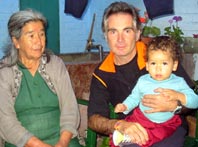

Comme j'en ai déjà parlé,
Silvia n'est pas, comme on pourrait dire, un coin tranquille et pour illustrer
ça j'ai pris une photo de la voiture de la police. Le véhicule
est couvert de trou de balles. L'année dernière, la guérilla
a fait sauter le poste de police tuant deux policiers et en blessant quelques
dizaines au passage.
Samedi 20 décembre 2003
Voilà, j'ai passé une semaine formidable à Silvia et
beaucoup de gens insistent pour que je reste jusqu'à Noël avec
eux, c'est tentant car de
passer
un Noël dans une communauté indienne serait une expérience
inoubliable. Le problème c'est que je connais une personne qui est en
relation avec la guérilla et cette personne me dit que ces derniers
ont demandé beaucoup de question à mon sujet. Qu'est ce que je
fais ici? Pour qui je travaille? Quand est ce que je vais repartir? Etc.. La
personne me conseille de partir le plus vite possible. Je vais disparaître
demain matin, à l'aube, vers l'Equateur. Je ne veux pas pousser ma chance
trop loin. Il me reste encore 800 Km pour gagner l'Equateur et il y a une ou
deux places que j'aimerai visiter au passage avant de faire mes adieux à
la Colombie.
L'année dernière, j'ai passé Noël au Kenya, cette
année ce sera soit la Colombie ou l'Equateur.
Ride4kids vous souhaite à tous un joyeux Noël et beaucoup de prospérité
pour la nouvelle année.
Felix Navidad.
What
will father Christmas bring me this year?
Qu'est ce que le père Noël va m'apporter cette année?
The Valley of Cocora.
La vallée de Cocora.
The colonial town of Salento.
Le village colonial de Salento.
Promenade in the Valley of
Cocora.
Une promenade dans la Vallée de Cocora.
Arriving in Silvia.
Avec mes amis de Silvia.
The chivas, a wooden local
bus. (Silvia)
Une chivas, un bus en bois. (Silvia)
A Guambiano family.
Une famille Guambiano.
Guambianos women.
Deux femmes Guambianos.
The faces of innocence.
Des visages innocents.
 |
 |
 |
 |
 |
 |
 |
 |
 |
 |
 |
 |
 |
|
JOURNAL 30.
20/12/03 . Colombia . Total
mileage so far 56,115km .
(Pour la version française
du journal, allez au bas de la page ou cliquez
içi.
Pour revenir à la version française du site, cliquez
sur Français)
How
can you help make Ride4Kids a worthwhile project? To find out,
click here.
|
|



